RIT History
1829 Colonel Nathaniel Rochester and other Rochester community leaders founded the Athenaeum, an association “for the purpose of cultivating and promoting literature, science, and the arts.” The Athenaeum was located in the Reynolds Arcade and housed a meeting room and a small reading room with a library, provided by Abelard Reynolds. The Rochester Athenaeum grew into a popular cultural center for Rochesterians. It offered public lectures and debates, and began establishing a substantial library.
1847 The Athenaeum merged with the Mechanics Literary Association, founded in 1836 by William A. Reynolds (son of Abelard Reynolds), to form the Rochester Athenaeum and Mechanics Association. It continued the tradition of public lectures, book reviews, and debates. The two groups merged their literary collections to create a singular library of more than 8,000 volumes covering a variety of subjects. Lectures were held at Corinthian Hall, which could hold 1,100, and distinguished speakers included Charles Dickens, Ralph Waldo Emerson, Oliver Wendell Holmes, and Frederick Douglass.
1885 Mechanics Institute is founded. Captain Henry Lomb, Max Lowenthal, Ezra Andrews, Frank Ritter, William Peck, and other Rochester businessmen and influential citizens established a school to provide needed technical training for skilled workers in industry. Lomb was the first president of the Board of Trustees and guided the direction of the institute until his death in 1908. Eugene Colby was appointed first teacher and principal of the Mechanics Institute. All funds for running the school were donated by the citizens of Rochester and instruction was free for the first year.
The first class offered at the newly formed Mechanics Institute was mechanical drawing, held in the evening on November 23, 1885. The community response is overwhelming. More than 400 students enrolled in the institute.
1886 Fine Arts classes are added to the institute's course offerings. Included are freehand drawing, architectural drawing, and design.
Tuition is $8 a term for drawing, $12 for painting and modeling. Evening classes are free.
1891 Rochester Athenaeum and Mechanics Institute merge, bringing under one roof cultural education and practical technical training. Enrollment reaches 1,000 students.
1893 Cooking classes begin in March 1893. The course consists of 26 lessons in practical cookery.
1894 Manual Training Building is the first official building erected by the institute. It later becomes known as the Eastman Annex. The building contains machine shops, classrooms, and a lecture hall.
The manual training department is created, with classes in joinery and bench, and later, pattern making and forging.
1901 The Eastman Building opens on Plymouth Avenue and the Erie Canal Aqueduct. George Eastman, founder of Eastman Kodak Co., donates the funds for this building and is an active benefactor of the institute until his death in 1932.
1903 The Mechanics Institute establishes five academic departments:
- Industrial Arts – Eugene Colby, Superintendent
- Mechanic Arts and Sciences – language, mathematics, science, Roland Woodward, Superintendent
- Manual Training – three members of board would supervise: James E. Gleason, Frank A. Brownell, Henry Lomb
- Domestic Science and Art – Mary Bliss, Superintendent
- Department of Fine Arts – direction of Bevier Memorial Committee: Adelbert Cronise, Dr. E.V. Stoddard, Harold C. Kimball, Lewis P. Ross, Charles H. Wiltsie
3,000 students enroll.
1909 First student publication The Institute Breeze published. Cover design and drawings by students in the Fine Arts Department.
1910 First president, Carleton B. Gibson, appointed. He served until 1916.
1912 The cooperative education program is started by President Gibson. Students find positions in industry and gain valuable, practical work experience before they graduate. At the time students worked in stores, factories, restaurants, and hospital kitchens.
Alumni association formed. Group numbers 200 graduates of the institute.
Publication of Ramikin, the student yearbook, began.
1916 James F. Barker appointed president. He served until 1919.
1919 Royal B. Farnum appointed president. He served until 1921.
1922 John A. Randall appointed president. He served until 1936.
1923 Four-year cooperative retail distribution program started.
1926 A course in industrial chemistry started.
1930 The department of photography is founded. Frederick Brehm is an instructor. He is later joined by C.B. Neblette.
2,210 students are enrolled in the institute.
1936 Mark Ellingson appointed president. He served until 1969.
1937 Empire State School of Printing, now the School of Print Media, acquired through the efforts of Frank Gannett.
1940 Classes offered all day and all night to train thousands for jobs in the defense industry.
Enrollment at the institute now reaches 4,565 students.
1942 The institute’s Evening School opens to women to assist in the war effort.
The Counseling Center is established to provide personal and career counseling to students.
1944 The institute adopts the name Rochester Institute of Technology.
1950 The Graphic Arts Research Center established to “apply scientific and engineering principles to the printing and publishing industry.” RIT is a center of research on all aspects of the graphic arts.
The School for American Craftsmen, now called School for American Crafts, founded by Mrs. Vanderbilt Webb, moved to RIT.
Enrollment reaches 4,376 students.
RIT becomes the first technical school to offer an associate degree in applied science in New York state.
1952 RIT acquires the McKechnie-Lunger School of Commerce in Rochester, which later becomes the College of Business.
1955 The first bachelor of science degrees are awarded.
1960 The first master’s degrees are awarded (all master of fine arts degrees).
Enrollment reaches 8,546 students.
Edwina Hogadone is appointed the first dean of the College of Business. Starting at RIT as a teacher of salesmanship, personnel, and merchandising in 1931, she is the first female dean at RIT and first woman in the nation named to head a college of business.
RIT is organized into six colleges: the College of Applied Science, the College of Business, the College of Fine and Applied Arts, the College of Graphic Arts and Photography, the College of General Studies (renamed the College of Liberal Arts in 1968) and Evening Studies.
1961 The institute makes the decision to move from downtown Rochester to a new location. Land in Henrietta, N.Y., is purchased and construction on a new campus begins in 1964.
1963 The College of Science is established.
1965 The first Outstanding Teacher Award, to recognize and encourage excellence in teaching at RIT, is given out. In 1974 the name was changed to the Eisenhart Awards for Outstanding Teaching.
1966 RIT is chosen as the home campus for the federally sponsored National Technical Institute for the Deaf, which had been established in 1963 by Public Law 89-36 and signed by President Lyndon B. Johnson. In a national report the institute’s long history of technical education, cooperative education, and its emphasis on career preparation were cited as the reasons for the choice.
1967 The Nathaniel Rochester Society is formed to formalize and encourage a closer relationship between RIT and members of the community.
1968 RIT moves to its new campus in Henrietta. The Dedication Ceremony takes place during Homecoming Weekend in October 1968.
The first freshman class enters NTID.
1969 Dr. Paul Miller is appointed president. He served until 1979.
1970 Institute enrollment now reaches 10,941 students.
1971 RIT offers graduate engineering course work via closed-circuit TV at local factories.
The College of Engineering is established.
1972 A Criminal Justice program is announced. The emphasis of program is on prevention and rehabilitation.
The School of Computer Science and Technology is established.
1974 A new complex for NTID is dedicated.
1978 A new bachelor of science program in biomedical computing is established.
1979 The RIT Distance Learning program is created.
Dr. Richard Rose is appointed president. He served until 1992.
RIT celebrates its 150th anniversary. The 150th Anniversary Fund capital campaign, which topped its $42 million goal, concludes. Entertainer Bob Hope visits RIT and joins in the celebration.
The Eisenhower College is acquired by RIT.
RIT continues to expand with many new departments and programs through the end of the seventies, including the department of packaging science and the department of instructional technology. Newly offered master’s degrees in clinical chemistry, computer and information science, and glass art expand the institute’s advanced degree offerings. New bachelor of science programs in biomedical communications and nuclear medicine, as well as an associate degree program in clinical technology, are also established.
1980 The RIT Research Corporation is formed to provide opportunities for collaborative projects with industry and government in imaging and information processing.
Enrollment now reaches 15,704 students (includes Eisenhower College).
1982 RIT installs a campus-wide computer network with 300 “intelligent” terminals.
The microelectronic engineering program is established. The program is the first undergraduate program in the field in the U.S.
1983 A program in biotechnology begins.
1986 The Center for Microelectronic and Computer Engineering is dedicated. Facility serves as a center for undergraduate education and research in the design and fabrication of integrated circuits.
1986-1987 RIT’s annual tuition is $7,701; with room, board, and fees the grand total is $12,659.
1987 Rochester Athenaeum founded to provide educational and enrichment programs for individuals over 50 years of age.
1989 The International Center of Hearing and Speech Research is opened to conduct research on the prevention, early detection, diagnosis, and treatment of people with hearing loss.
A program in telecommunications engineering technology is started. It is the first bachelor of science program in telecommunications engineering technology in the United States to be accredited by the Technology Accreditation Commission of the Accreditation Board for Engineering and Technology (TAC-ABET).
The Chester F. Carlson Center for Imaging Science is dedicated. The building houses the new program in imaging science.
The Bausch & Lomb Center is dedicated. Bausch & Lomb Corp. provided funding for the building as part of RIT’s Access to the Future capital campaign.
RIT sponsors the United States Business School in Prague, with a program leading to an MBA degree, for students in the Czech Republic and other Central and Eastern European countries.
1990 RIT enrollment now reaches 13,195 students.
RIT’s first Ph.D. program is established. The program, in Imaging Science, is the first Ph.D. program of its kind in the U.S.
1991 RIT offers full degree programs online.
Construction of the Hale-Andrews Student Life Center is completed.
Commission on Cultural Diversity (now called the Commission for Promoting Pluralism) is established. The goals of the commission include articulating an institutional commitment to a pluralistic campus environment and promoting diversity as an institutional value.
1992  RIT’s eighth president, Albert Simone, is appointed.
RIT’s eighth president, Albert Simone, is appointed.
The bachelor of science degree program in information technology is established. The training emphasizes understanding technology from the point of view of the user.
1993 The Women’s Resource Center is created.
1995 Margaret’s House, an expanded child care center serving members of the RIT community, is dedicated. Al Davis, vice president emeritus and long-time supporter of RIT, gave the funding for the center in memory of his wife, Margaret Welcher Davis.
1996 An undergraduate program in software engineering, the first of its kind in the U.S., is established.
The College of Engineering announces the Kate Gleason Scholarship for Women. Kate Gleason donated $300,000 to the institute in 1933, and the family has continued to generously support RIT until the present, including a very large gift from James and Janis Gleason on behalf of the Gleason Foundation in 1998 to support the College of Engineering’s programs.
1997 The Center for Integrated Manufacturing Studies, created with $20.75 million in federal and state funding, opens with a mission to increase the competitiveness of manufacturers through technology solutions and training.
The American College of Management and Technology opened in Dubrovnik, Republic of Croatia. ACMT is a collaborative effort between RIT’s College of Applied Science and Technology and Velecillste Dubovnikú, the Polytechnic of Dubrovnik.
1998 The College of Engineering is renamed the Kate Gleason College of Engineering.
Announcement of First in Class, an initiative to invest in areas of strength that will result in RIT “being the university of choice” through partnerships with industry and government.
The Center for Excellence in Mathematics, Science, and Technology, established through a challenge gift by Thomas Gosnell, is dedicated. This major addition to the College of Science features the Bruce and Nora James Atrium, which features a polished granite floor by artist Larry Kirkland. The floor is etched with symbols representing milestones in the history of science.
A fiber-optic cable network is installed in all academic buildings on campus and provides the campus with an Ethernet connection.
2000 Enrollment now reaches 14,642 students.
2001 The B. Thomas Golisano College of Computing and Information Sciences is formed. The new college includes programs in computer science, information technology, and software engineering.
The Joseph F. and Helen C. Dyer Arts Center opens. The gallery hosts traveling exhibits and features NTID’s permanent collection of works by deaf, hard-of-hearing, and hearing artists.
A new master of science degree program in communication and media technology, an interdisciplinary program in the social sciences, humanities, and applied technologies is established. The program builds on RIT strengths in liberal arts, digital media and publishing, information technology, and e-business.
RIT is designated as a New York State Strategically Targeted Academic Research (STAR) Center as part of a state initiative to promote high-technology businesses in New York.
The IT Collaboratory is formed. The collaboratory is a state-funded joint project with the University of Buffalo and Alfred University. The center will focus on four areas of research: microsystems, photonic systems, remote systems, and high-bandwidth telecom networks. It will also investigate new technologies not yet in use, serve as a test bed for new product development and product enhancement, and take part in collaborative research with industry as well as provide training programs contributing to economic development in western New York.
2002 A web-based course management system, myCourses, is offered. Instructors can post information and files for a course to the class website, as well as utilize e-mail lists, discussion boards, and live chat rooms.
New bachelor of science and master of science programs in bioinformatics are created. The new programs merge biotechnology and information technology.
RIT opened the North Star Center for Academic Success and Cultural Affairs. The center serves as a source of guidance for the recruitment, retention, and graduation of RIT’s AALANA student population.
A Ph.D. program in microsystems engineering, the first in the country, is established. The program is part of the Kate Gleason College of Engineering.
2003 A new master of science degree in telecommunication engineering technology is offered.
RIT SportsZone debuts on ESPN2. The student-produced program highlights athletics at RIT with individual profiles and in-depth features.
Heidelberg Bruckmaschinen AG installs its most advanced commercial web press, called "Sunday 2000," on campus in the newly dedicated Heidelberg Web Press Laboratory. The press will be used for research and education in RIT’s School of Print Media.
The Sentinel, a 70-foot, 110-ton steel sculpture by Albert Paley, is dedicated. The sculpture is located in a central location and serves as focal point at the main entrance of the campus.
The College of Applied Science and Technology establishes a new program in collaboration with the American University Foundation in Kosovo. Students pursue course work in various subjects, including service management, business development, economics, and marketing.
2004 T. Alan Hurwitz is inaugurated as vice president of RIT and dean for RIT’s National Technical Institute for the Deaf, the culmination of his 34-year career at the institute.
RIT kicks off a year-long celebration of the institute’s 175th anniversary.
The Gordon Field House and Activities Center opens. The 160,000-square-foot facility includes an aquatics center, a two-story fitness center, and a 60,000-square-foot multi-use arena and indoor athletic field.
RIT enrollment now reaches 15,400 students.
Commemorating RIT’s 175th anniversary, members of RIT’s cross country team complete a Coast-to-Coast Run, covering 30 states and four time zones in 12 days, 3 hours, and 48 minutes. The run breaks a record set by RIT runners in 1979, who crossed the country to commemorate the university’s 150th anniversary.
RIT announces that the men’s hockey program will join the Division I Atlantic Hockey Association. The move to Atlantic Hockey will be phased in over three years, with Division I games starting in 2005.
2005 The nation’s first lab for social computing is established as part of the B. Thomas Golisano College of Computing and Information Sciences’ new research initiative, the Center for Advancing the Study of Cyberinfrastructure.
McAfee Inc. donates more than $1 million in technology to the B. Thomas Golisano College of Computing and Information Sciences as the college launches a master’s degree program in computer security and information assurance.
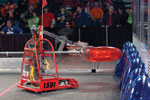
For the first time, RIT hosts the Finger Lakes Regional FIRST Robotics Competition. Thirty-three teams of high school students from across the Northeast participate in a sports-style contest featuring remote-controlled robots designed, built, and programmed by students.
Construction begins on RIT’s $12 million, 35,000-square-foot Center for Bioscience Education and Technology.
The Bausch & Lomb Foundation commits $2.5 million to fund the Bausch & Lomb Endowed Chair in Microsystems Engineering in RIT’s Kate Gleason College of Engineering.
2006 The IT Collaboratory building, a three-story research facility adjacent to the Center for Microelectronics and Computer Engineering, opens.
For the first time at RIT, a course (a graduate class in applied multivariate statistics) is delivered via podcast.
RIT’s eighth president, Albert J. Simone, announces his plans to retire in mid-2007.
The E. Philip Saunders College of Business is named, honoring a successful entrepreneur who donated $13 million to the university’s academic business programs.
With $309 million in gifts and commitments, President Albert J. Simone announces the successful conclusion to “Powered by the Future: The Campaign for RIT,” the university’s eight-year comprehensive fundraising campaign.
A Ph.D. program in computing and information sciences is launched by the B. Thomas Golisano College of Computing and Information Sciences. This marks RIT’s third Ph.D. program.
RIT joins Constellation Brands, Wegmans Food Markets, and the New York Wine and Grape Foundation as primary partners in the non-profit New York Wine and Culinary Center. The $7.5 million facility opens in Canandaigua, N.Y.
2007 RIT launches a Ph.D. degree program in color science, the first in the world.
William W. Destler is named RIT’s ninth president. Destler, former senior vice president for academic affairs and provost of the University of Maryland at College Park, succeeds Albert J. Simone, RIT’s president from 1992 to 2007.
RIT’s Center for Bioscience Education and Technology opens. The $12 million, 35,000-square-foot facility is a national model for comprehensive academic, community and career-training programs in biotechnology and medical sciences.
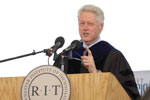
Former U. S. President William Jefferson Clinton is keynote speaker at RIT’s 122nd Commencement celebration. More than 3,500 students graduate, and the number of living RIT alumni reaches the 100,000 mark.
More than 141 teams from all over the world participate in the Baja SAE Rochester World Challenge, a collegiate engineering design competition hosted by RIT.
The Golisano Institute for Sustainability is established at RIT with a founding commitment of $10 million from RIT Trustee B. Thomas Golisano, founder and chairman of Paychex Inc.
RIT’s Kate Gleason College of Engineering opens a multi-million dollar research wing funded through the efforts of donors including the Gleason Foundation, the Brinkman Family Foundation and Harris Corp.
2008 RIT opens a campus in Dubai, United Arab Emirates. Funded by the Dubai government, RIT Dubai is part of Dubai Silicon Oasis. RIT provides academic content, leadership and management of the university.
Jeremy Haefner, a veteran administrator and educator from the University of Colorado at Colorado Springs, becomes RIT’s senior vice president for academic affairs and provost.

The first Imagine RIT: Innovation and Creativity Festival draws more than 15,000 visitors to campus to see more than 400 interactive exhibits and displays, including new ideas for products and services, creative arts and crafts, and faculty and student research.
RIT opens its first “green” building, the new College of Applied Science and Technology Building. The $10.5 million, 33,600-square-foot facility meets the standards of the most widely accepted rating system for evaluating sustainable, high-performance buildings.
The College of Science launches a doctoral degree program in astrophysical sciences and technology. The Golisano Institute for Sustainability creates the world’s first Ph.D. program focused on sustainable production.
RIT and Rochester General Health System begin a strategic alliance.
2009 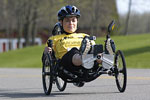 The second annual Imagine RIT: Innovation and Creativity Festival draws more than 25,000 visitors to campus. In addition to more than 2,000 exhibits and activities, the festival includes RIT President Bill Destler’s “Green Vehicle Challenge.”
The second annual Imagine RIT: Innovation and Creativity Festival draws more than 25,000 visitors to campus. In addition to more than 2,000 exhibits and activities, the festival includes RIT President Bill Destler’s “Green Vehicle Challenge.”

The Center for Student Innovation opens. The 10,000-square-foot facility will serve as a hub where students from all over the university can develop and showcase innovative and entrepreneurial projects.
2010  The RIT men’s hockey team catapults into the national spotlight by earning a trip to the NCAA’s prestigious Frozen Four. The team’s surprising success (a program with no athletic scholarships and only Division I for five years) brings new pride to Tiger fans across the globe.
The RIT men’s hockey team catapults into the national spotlight by earning a trip to the NCAA’s prestigious Frozen Four. The team’s surprising success (a program with no athletic scholarships and only Division I for five years) brings new pride to Tiger fans across the globe.
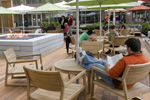
Global Village, RIT’s $57 million international-themed retail and residential complex, officially opens. The project takes the shape of a European courtyard complete with an international market, Mexican cantina and fresh sushi bar.
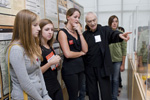
The iconic work of international designers Massimo and Lella Vignelli is permanently archived at a new design center, the Vignelli Center for Design Studies. The Vignellis created the New York City subway signage, the Handkerchief Chair, the Paper Clip Table, the Stendig calendar, the interior of St. Peter’s Lutheran Church in New York City, the corporate identity programs for Xerox, American Airlines, packaging programs for Bloomingdales and Saks Fifth Avenue, to name a few.
2011  The university breaks ground on a state-of-the-art “green” facility for its Golisano Institute for Sustainability. The building will serve as a center for sustainability research, technology transfer, education and outreach and will provide a showcase for green construction and design.
The university breaks ground on a state-of-the-art “green” facility for its Golisano Institute for Sustainability. The building will serve as a center for sustainability research, technology transfer, education and outreach and will provide a showcase for green construction and design.
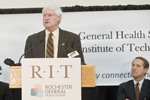
RIT and Rochester General Health System open the Institute of Health Sciences and Technology this September. Three distinct prongs comprise the institute: the College of Health Sciences and Technology, the Health Sciences Research Center and the Health Sciences Outreach Center.
2012 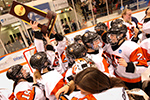 The women's hockey team wins the Division III NCAA national championship and also announces it will move up to the Division I level.
The women's hockey team wins the Division III NCAA national championship and also announces it will move up to the Division I level.
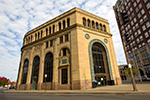 RIT announces it will contribute to the resurgence of the city of Rochester with a new Center for Urban Entrepreneurship located in the heart of downtown. An historical landmark building, the former Rochester Savings Bank, donated to RIT will serve as the home of the new center.
RIT announces it will contribute to the resurgence of the city of Rochester with a new Center for Urban Entrepreneurship located in the heart of downtown. An historical landmark building, the former Rochester Savings Bank, donated to RIT will serve as the home of the new center.
The Carnegie Foundation names Professor Todd Pagano, who teaches chemistry in the National Technical Institute for the Deaf, U.S. Professor of the year.
2013 RIT converts from the quarter academic calendar to the semester academic calendar.
Golisano Institute for Sustainability, which houses one of the world¹s first Ph.D. programs in sustainability, opens its doors to a new home. The institute conducts cutting-edge research in nanotechnology, alternative energy development and sustainable design. It is one of the greenest buildings in the world, powered by the sun, wind and fuel cell technology.
Sebastian and Lenore Rosica Hall opens at NTID. This space will serve as an innovation and research hub for NTID.
2014  The Gene Polisseni Center, home to men's and women's hockey, opens with a roar. The $38 million ice arena has capacity for 4,300 Tiger fans.
The Gene Polisseni Center, home to men's and women's hockey, opens with a roar. The $38 million ice arena has capacity for 4,300 Tiger fans.
RIT launches its seventh doctoral program, a Ph.D. in engineering.
2015 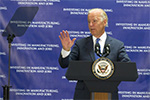 A New York-based consortium led by SUNY Polytechnic, RIT, and the University of Rochester is awarded a multimillion-dollar federal investment to create a national photonics center. The award was announced by Vice President Joe Biden and New York Gov. Andrew Cuomo.
A New York-based consortium led by SUNY Polytechnic, RIT, and the University of Rochester is awarded a multimillion-dollar federal investment to create a national photonics center. The award was announced by Vice President Joe Biden and New York Gov. Andrew Cuomo.
RIT unveils a state-of-the-art Battery Prototyping Center. The new center will work with companies and universities to develop the next generation of batteries.
 The photography staff of the St. Louis Post-Dispatch, which includes RIT alumnus David Carson, wins the Pulitzer Prize for Breaking News Photography. The award was for the newspaper’s coverage of the events in Ferguson, Mo., following the police shooting of Michael Brown, an unarmed black teenager, by a white police officer. Carson is one of eight RIT graduates who have won a combined 12 Pulitzer Prizes.
The photography staff of the St. Louis Post-Dispatch, which includes RIT alumnus David Carson, wins the Pulitzer Prize for Breaking News Photography. The award was for the newspaper’s coverage of the events in Ferguson, Mo., following the police shooting of Michael Brown, an unarmed black teenager, by a white police officer. Carson is one of eight RIT graduates who have won a combined 12 Pulitzer Prizes.
2016 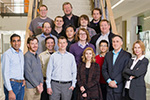 A monumental discovery will change the way scientists view the universe and RIT researchers played a key role in the revelation. Six RIT researchers are among the authors of a paper announcing what may be the most important scientific discovery in a century—findings that confirm the existence of gravitational waves predicted in Albert Einstein’s general theory of relativity.
A monumental discovery will change the way scientists view the universe and RIT researchers played a key role in the revelation. Six RIT researchers are among the authors of a paper announcing what may be the most important scientific discovery in a century—findings that confirm the existence of gravitational waves predicted in Albert Einstein’s general theory of relativity.
RIT is officially considered a “doctoral university” by the leading national classification of U.S. colleges and universities. The Carnegie Classification of Institutions of Higher Education elevates RIT from “Master’s – Comprehensive” to “Doctoral University.”
The university receives approval for its eighth doctoral program, a Ph.D. in mathematical modeling.
2017 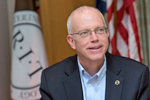 Dr. David C. Munson Jr. is named RIT’s 10th president, succeeding Bill Destler, who retired after 10 years of service. Dr. Munson is the former dean of the University of Michigan’s College of Engineering.
Dr. David C. Munson Jr. is named RIT’s 10th president, succeeding Bill Destler, who retired after 10 years of service. Dr. Munson is the former dean of the University of Michigan’s College of Engineering.
RIT is ranked among the top 100 national research universities by U.S. News and World Report for the first time.
More Information
Looking for more? The RIT Archive Collections is another excellent source of information regarding RIT’s history.
